The shift to remote work is more than a trend; it’s a fundamental change in how businesses operate. Without the right infrastructure, productivity can plummet, and team cohesion can evaporate. A well-chosen tech stack acts as the digital headquarters for your distributed team, facilitating seamless communication, transparent project management, and a strong company culture. This is why selecting the best tools for remote teams isn’t just an IT decision, it’s a core business strategy.
This guide moves beyond generic lists to provide a deep dive into the 12 essential platforms, categorized by their core function. We analyze each tool’s practical use cases, highlight its limitations, and offer implementation guidance to help you build a powerful, efficient, and connected remote-first environment. Our goal is to help you cut through the noise and find the specific software that solves your team’s unique challenges, from keeping projects on track to fostering a sense of community across time zones.
Whether you’re a startup refining its workflow or an enterprise scaling its distributed workforce, these tools are the building blocks for thriving in a world where the office is optional. We will cover a comprehensive suite of solutions, including platforms for communication, project management, time tracking, culture building, and security.
Inside this resource, you will find:
- Detailed analysis of each platform’s strengths and weaknesses.
- Practical implementation advice for seamless integration.
- Screenshots and direct links to help you evaluate each option quickly.
We’ve done the heavy lifting to provide a clear, actionable overview. Let’s explore the critical tools for remote teams that will empower your organization to succeed.
1. Remote First Jobs
Assembling a world-class remote team begins with sourcing top-tier talent, and Remote First Jobs stands out as a premier platform engineered for this exact purpose. It transcends the typical job board by creating a curated, spam-free ecosystem for both employers and job seekers dedicated to the remote-first model. With over 40,000 verified listings from more than 21,000 companies, it offers an unparalleled depth of opportunities, making it an essential tool for scaling remote teams effectively.
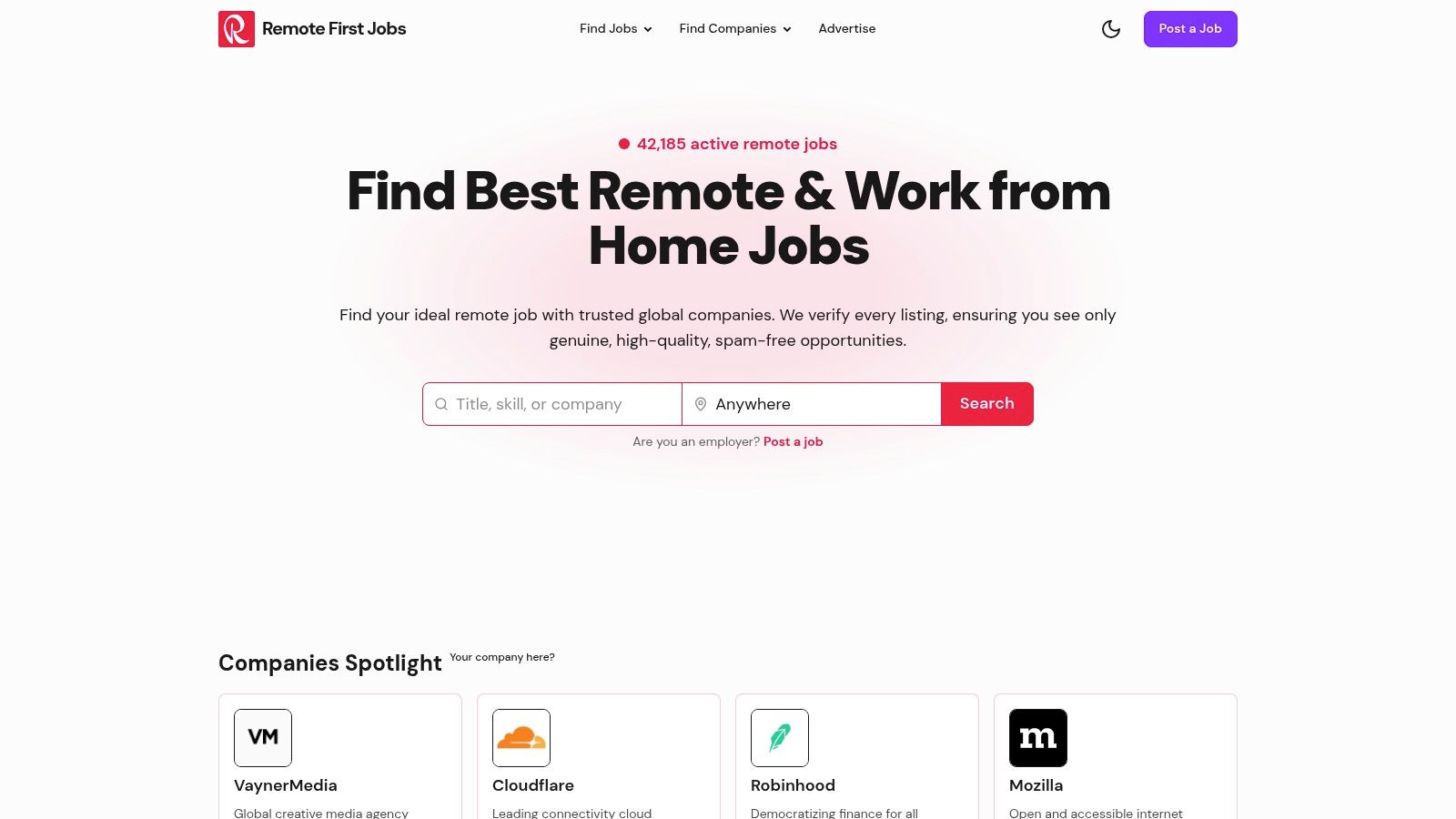
The platform’s strength lies in its meticulous verification process and advanced filtering capabilities. Unlike generic aggregators, every listing is vetted for legitimacy, ensuring that companies connect with serious professionals and candidates avoid fraudulent postings. This commitment to quality builds a foundation of trust that is critical in the remote hiring landscape. For managers, this means less time sifting through unqualified applicants and more time engaging with high-caliber talent.
Key Strengths and Use Cases
- For Recruiters: The platform offers a streamlined job posting process with features like automatic job detail integration and social media promotion. This simplifies the hiring workflow, allowing you to reach a targeted audience of remote-ready professionals quickly. Transparent pricing and no hidden fees make it a predictable and reliable recruitment tool.
- For Job Seekers: Candidates can leverage powerful search filters to find roles by skill, title, industry, and even specific location requirements for time zone alignment. This precision saves countless hours in the job hunt, connecting them with opportunities that genuinely match their expertise and career goals.
- For Team Integration: Finding the right person is only the first step. Especially for remote-first jobs, a robust onboarding process is vital to integrate new team members successfully and boost retention; discover strategies for streamlining the employee onboarding process for remote hires.
Beyond its core function as a job board, Remote First Jobs provides valuable resources, including expert articles on building a thriving remote work culture. These insights help companies not just hire, but also retain and nurture their distributed teams, a crucial aspect of long-term success.
Website: remotefirstjobs.com
2. Slack
Slack is a channel-based messaging platform that serves as the digital headquarters for countless remote teams. It centralizes communication, replacing fragmented email threads with organized, searchable conversations. The platform excels at creating dedicated channels for specific projects, teams, or topics, ensuring discussions remain focused and accessible.
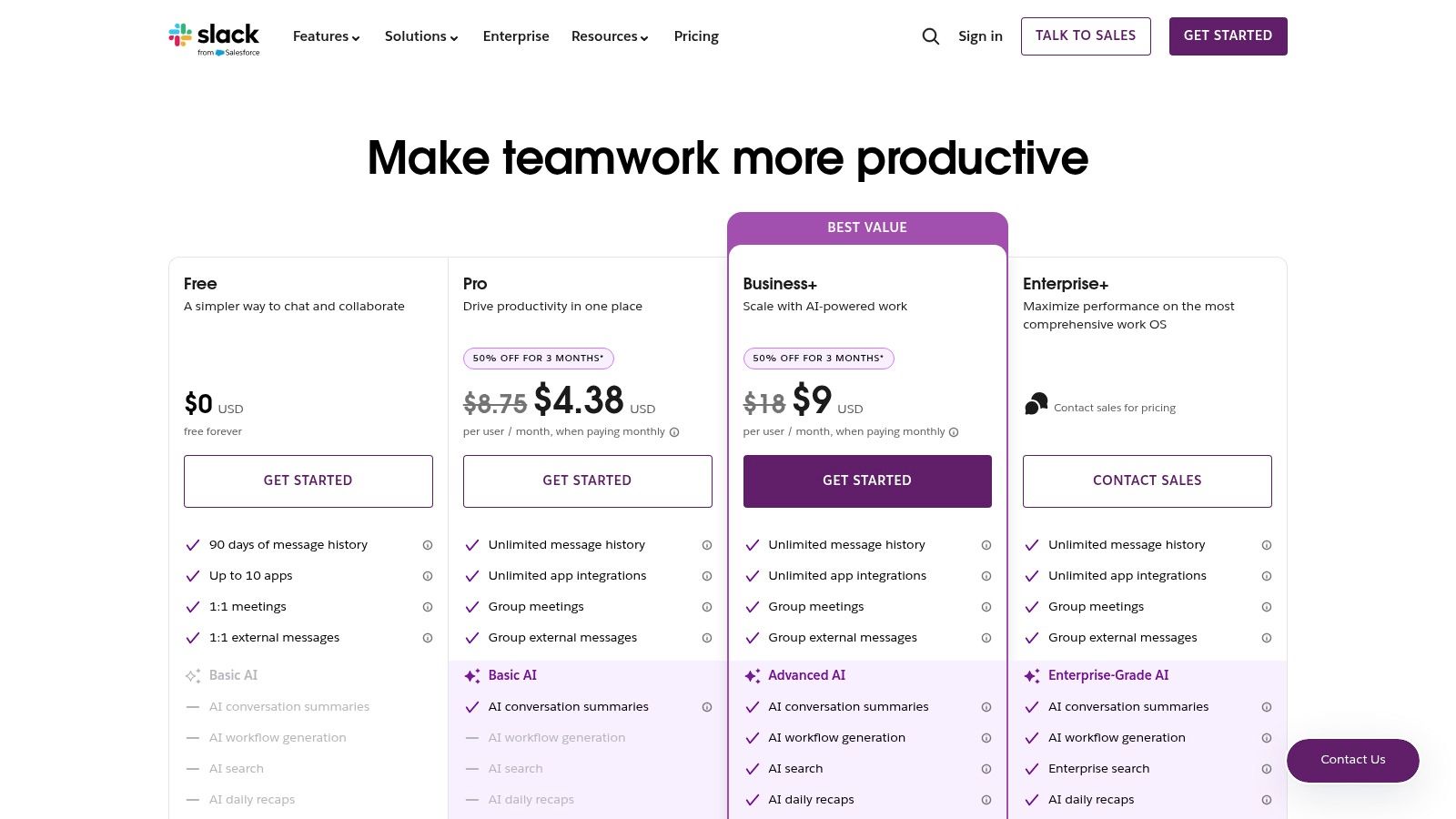
What sets Slack apart is its powerful integration ecosystem, boasting over 2,600 apps. This allows teams to connect tools like Google Drive, Jira, and Asana directly into their chat workflows, turning conversations into actionable tasks without leaving the platform. Its built-in AI features on paid plans, such as conversation summaries and smart search, further streamline information discovery, making it one of the most effective tools for remote teams looking to boost productivity.
Core Features & Limitations
Pros:
- Massive Integration Marketplace: Connects seamlessly with thousands of other business tools to automate workflows.
- Strong Security: Offers enterprise-grade security features and compliance certifications, which are crucial for maintaining data integrity. Learn more about best practices for remote team security to complement Slack’s offerings.
- Fair Billing: The per-active-user billing model helps manage costs by only charging for team members who are actively using the platform.
Cons:
- Limited Free Plan: The free version restricts message history to the last 90 days, which can be a significant drawback for teams needing long-term archives.
- Rising Costs: Pricing for the Business+ plan increased in 2025, with some advanced features shifting to more expensive enterprise tiers.
Website: https://slack.com
3. Microsoft Teams
Microsoft Teams is a comprehensive communication and collaboration hub deeply embedded within the Microsoft 365 ecosystem. It combines persistent chat, video meetings, file storage, and application integration into a single workspace, making it a powerful choice for organizations already invested in Office apps. The platform facilitates real-time co-authoring of Word, Excel, and PowerPoint files directly within its interface, eliminating the need to switch between applications.
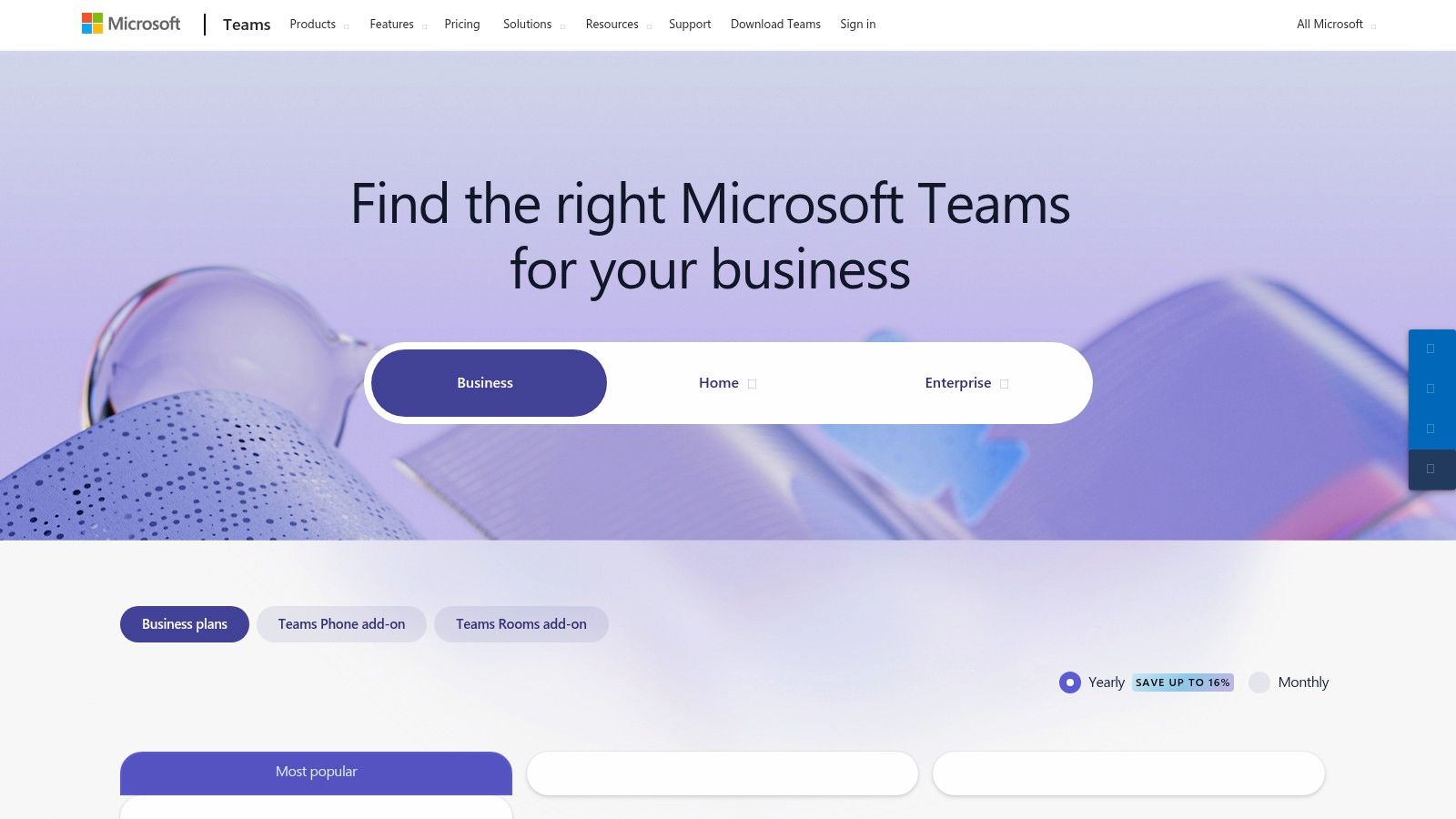
What sets Microsoft Teams apart is its seamless integration with the broader Microsoft suite, including Outlook and SharePoint, creating a unified workflow for communication and document management. Its structure of teams and channels helps organize conversations by project or department, ensuring information is both contextual and easily retrievable. With flexible licensing options and add-ons like Teams Premium for AI-powered features and Teams Phone for PSTN calling, it scales from small businesses to large enterprises, solidifying its place among the essential tools for remote teams.
Core Features & Limitations
Pros:
- Tight Integration with Microsoft Office: Offers unparalleled live collaboration on Word, Excel, and PowerPoint documents directly within the app.
- Flexible Licensing: Provides a wide range of plans, from a capable free version to enterprise-level bundles with Microsoft 365, catering to diverse organizational needs.
- Robust Security: Leverages Microsoft’s enterprise-grade security and governance features, ensuring data protection and compliance across the platform.
Cons:
- Feature Sprawl: The vast number of features can lead to a steeper learning curve and increase administrative complexity for IT teams.
- Paid Add-ons Required: Accessing some of its most advanced capabilities, such as intelligent meeting recaps or advanced webinar features, requires purchasing additional licenses like Teams Premium.
4. Zoom
Zoom has become synonymous with video conferencing, offering a robust platform for virtual meetings, webinars, and real-time collaboration. Its reputation is built on high-definition video and reliable audio quality, which are critical for maintaining clear communication in synchronous remote work. The platform extends beyond simple video calls to include persistent team chat, collaborative whiteboards, and a comprehensive phone system.
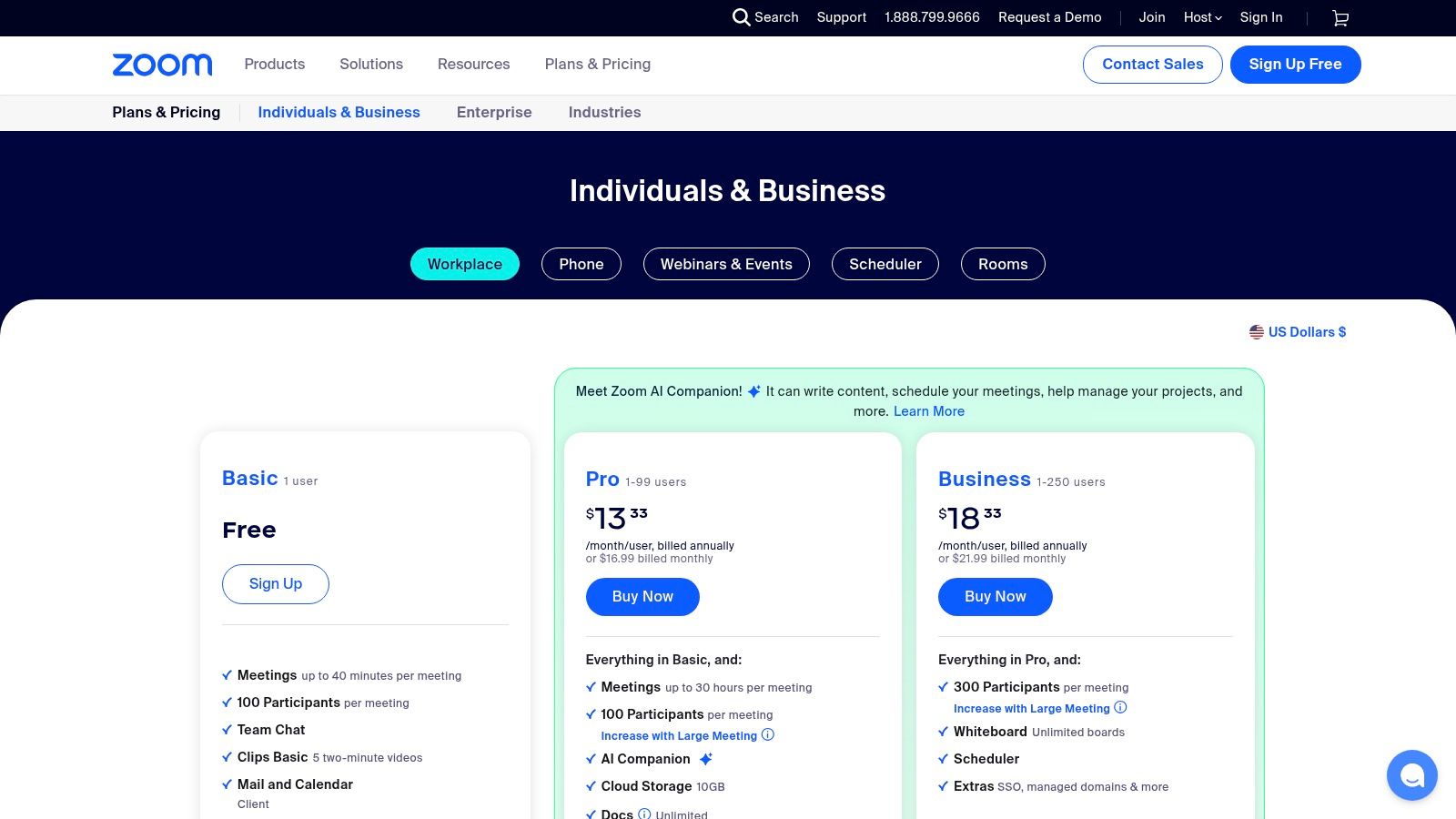
What makes Zoom an indispensable tool for remote teams is its scalability and versatility. It can support everything from one-on-one check-ins to large-scale webinars with thousands of attendees. Features like live captions, recording, and an extensive ecosystem of hardware and software integrations allow teams to create a professional and inclusive meeting environment. Efficiently running these meetings is key, which is why leaders should learn more about best practices for managing remote teams to maximize the tool’s effectiveness.
Core Features & Limitations
Pros:
- Strong Video and Audio Reliability: Delivers consistent, high-quality performance even with fluctuating internet connections, which is crucial for distributed teams.
- Extensive Add-on Ecosystem: Offers a wide range of integrations and add-ons like Zoom Phone, Rooms, and Webinars to create a unified communications hub.
- Transparent Global Options: Provides clear and accessible global dial-in coverage and rates, simplifying international collaboration.
Cons:
- Pricing Complexity: The tiered pricing structure with numerous add-ons can make it difficult to predict final costs without careful planning.
- Expensive for Large Events: Licensing for webinars and large meetings can become costly, requiring careful management to avoid budget overruns.
Website: https://zoom.us/pricing?utm_source=openai
5. Google Workspace
Google Workspace is an integrated suite of cloud-native productivity and collaboration tools that acts as a central hub for many remote teams. It bundles familiar applications like Gmail, Drive, Docs, Sheets, and Meet into a single, cohesive environment, allowing for seamless transitions between communication, content creation, and file storage. The platform is designed for real-time, simultaneous collaboration, making it ideal for distributed teams working on documents and presentations together.
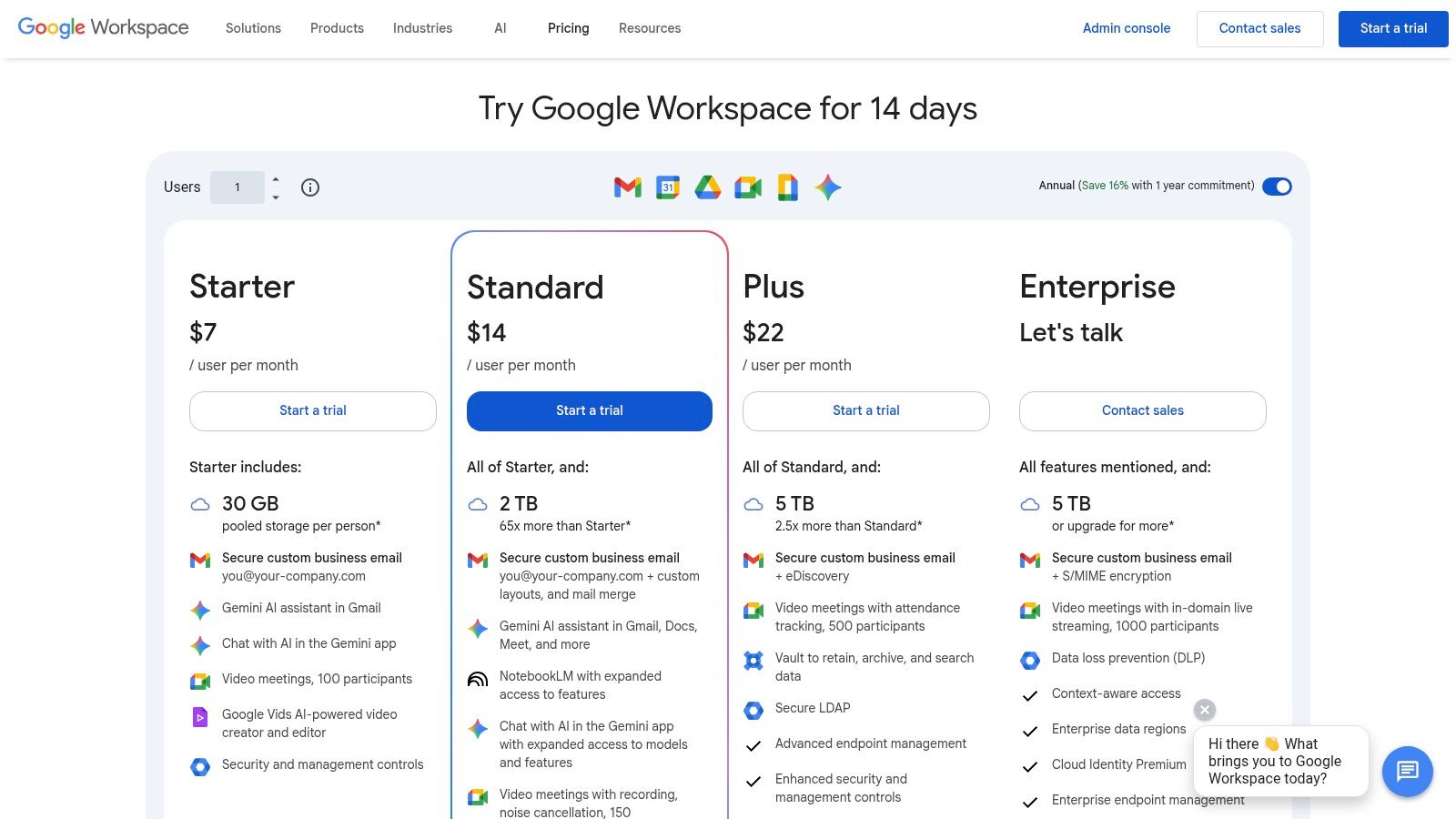
What truly makes Google Workspace one of the essential tools for remote teams is its deep integration and simplicity. Creating a business email is straightforward, and sharing a file from Drive directly within a Google Meet call takes just a few clicks. The recent addition of Gemini AI across the suite (available on certain plans) further enhances productivity by helping draft emails, summarize documents, and generate content, keeping teams efficient without a steep learning curve.
Core Features & Limitations
Pros:
- Intuitive Collaboration: Its cloud-first design provides an incredibly simple and familiar interface for real-time co-editing and sharing.
- Integrated AI Features: Gemini for Workspace is embedded directly into core apps, offering practical assistance for everyday tasks.
- Straightforward Pricing: Offers clear, per-user pricing tiers with free trials, making it accessible for businesses of all sizes to get started.
Cons:
- Storage Policy Changes: The move to pooled storage from individual allotments may require administrators to establish new usage policies to manage space effectively.
- Microsoft Office Reliance: Teams deeply embedded in the advanced features of desktop Excel or PowerPoint may find the web-based Sheets and Slides less robust for complex tasks.
Website: https://workspace.google.com/pricing?hl=us&utm_source=openai
6. Asana
Asana is a project and portfolio management tool designed to help remote teams organize, track, and manage their work. It moves beyond simple task lists, providing a comprehensive platform where teams can plan entire projects, from high-level goals down to daily to-do items. Its strength lies in offering multiple views like lists, boards, and timelines, allowing team members to visualize work in the way that makes the most sense for them.
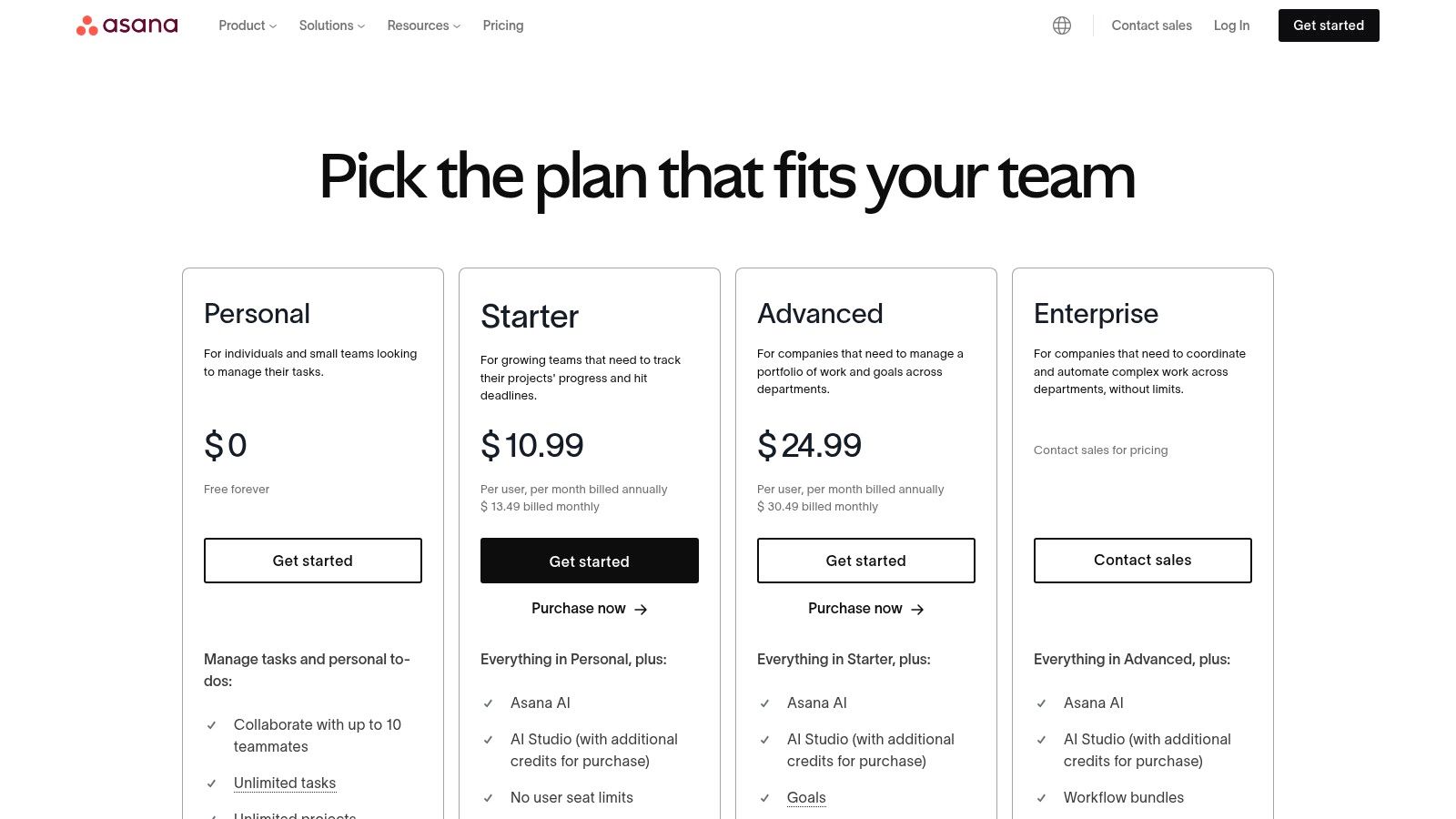
What sets Asana apart is its focus on aligning daily tasks with overarching company objectives through its Goals feature. This top-down visibility ensures that every team member understands how their contributions impact the bigger picture. With the recent integration of Asana AI, the platform now assists with workflow automation and smart project planning, making it an indispensable tool for remote teams aiming to connect strategy with execution. By centralizing project data and communication, it helps teams streamline their processes and ultimately improve workplace efficiency.
Core Features & Limitations
Pros:
- Clear Visualization: Multiple project views (Timeline, Boards, Gantt) provide clarity on work progress and dependencies.
- Strong Reporting: Powerful reporting dashboards and goal alignment features help track performance against strategic objectives.
- Generous Guest Access: Easily collaborate with external partners, clients, or freelancers without needing to purchase full licenses for them.
Cons:
- Gated Advanced Features: Critical functionalities like portfolio management and workload balancing are reserved for higher-tier, more expensive plans.
- Seat-Based Billing: The per-user pricing model can become costly as teams scale, requiring careful license management.
Website: https://asana.com
7. monday.com
monday.com is a highly visual and flexible Work Operating System that allows remote teams to manage everything from simple tasks to complex, cross-functional projects. Its core strength lies in its customizable boards, which can be adapted for a huge range of use cases, including project management, CRM, software development, and marketing campaigns. This adaptability makes it one of the most versatile tools for remote teams with diverse operational needs.
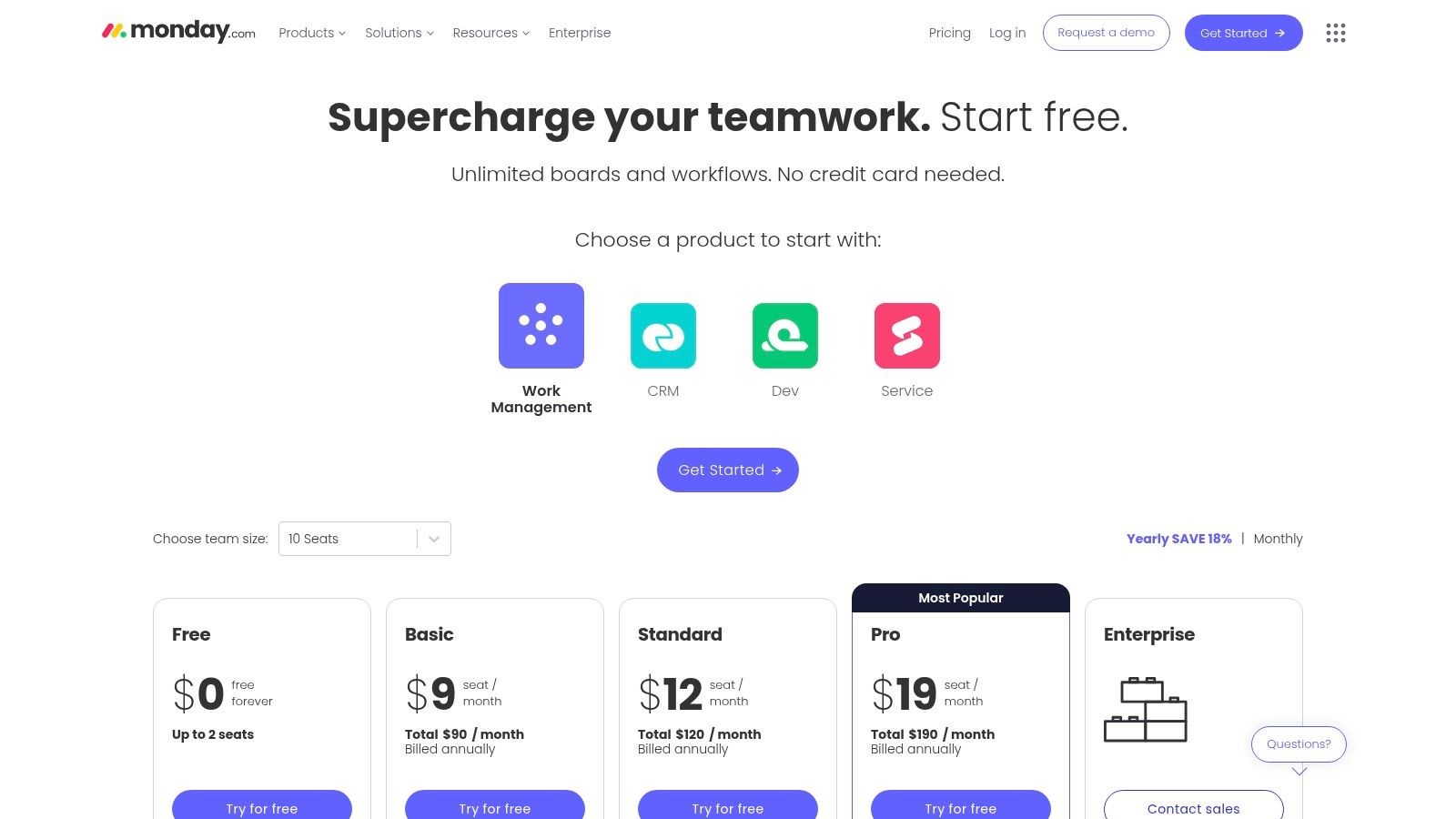
What sets monday.com apart is its user-friendly interface combined with powerful workflow automation. Teams can set up rules to automate repetitive tasks, such as sending notifications when a status changes or creating new items based on triggers. With its rich visual dashboards and multiple views like Gantt and Kanban, managers get a clear, real-time overview of progress, resource allocation, and potential bottlenecks, all in one centralized hub.
Core Features & Limitations
Pros:
- Extensive Customization: Offers a vast library of templates and customizable columns to fit almost any workflow or industry.
- Scalable: The platform scales effectively from small teams managing simple to-do lists to large organizations running complex, enterprise-wide operations.
- Strong UI/UX: Its clean, colorful interface and robust mobile app support make it intuitive and easy for team members to adopt.
Cons:
- Seat-Based Pricing: Pricing increases significantly with more users and often requires purchasing seats in packs, which can be costly for smaller teams.
- Segmented Features: Some advanced functionalities, like time tracking or specific views, are locked behind higher-tier plans or specialized product SKUs.
Website: https://www.monday.com/pricing?utm_source=openai
8. Atlassian (Jira & Confluence)
Atlassian’s suite, featuring Jira and Confluence, offers an industry-standard combination for technical project management and knowledge sharing. Jira is a powerhouse for agile teams, providing robust issue tracking, scrum and kanban boards, and detailed roadmaps. Paired with Confluence, it creates a unified space where project plans live alongside comprehensive documentation and team knowledge bases.
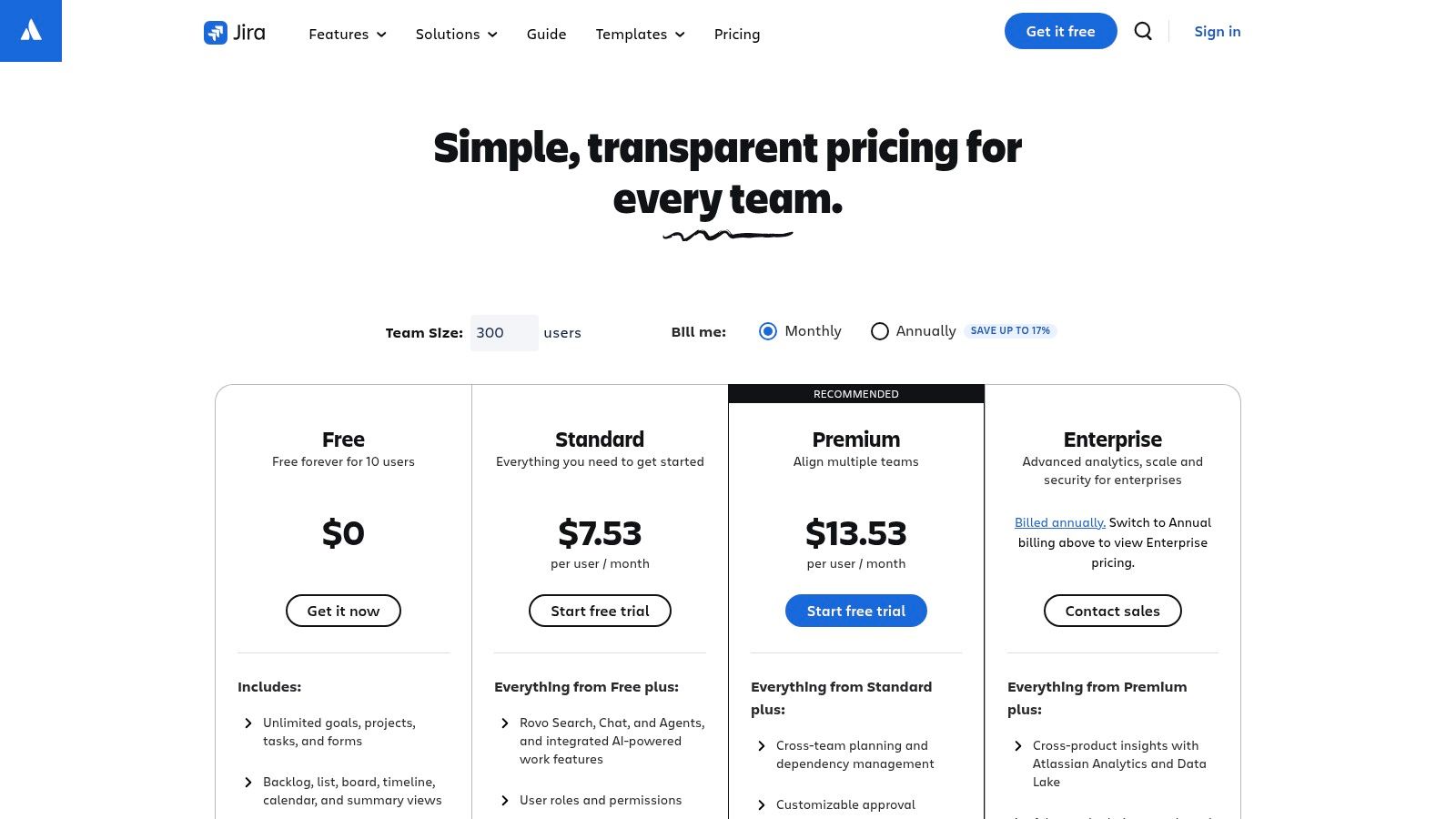
What makes this duo one of the essential tools for remote teams, particularly in engineering and product development, is its deep integration and specialization. Teams can link Jira epics directly to Confluence design documents, meeting notes, and OKRs, creating a single source of truth that connects high-level strategy to daily tasks. The extensive marketplace for add-ons further allows organizations to customize workflows precisely to their needs, from test management to time tracking.
Core Features & Limitations
Pros:
- Deep Agile Capabilities: Offers comprehensive features for scrum, kanban, and backlog management, with powerful reporting.
- Mature Ecosystem: Provides enterprise-grade security with SSO and SCIM support, essential for large, distributed organizations.
- Flexible Hosting: Supports both cloud and data center deployments, giving teams control over their data and compliance requirements.
Cons:
- Complex Administration: The platform’s extensive customization options can be overwhelming and complex for non-technical teams to manage.
- Hidden Costs: While powerful, the reliance on marketplace add-ons for specific functionalities can significantly increase the total cost of ownership.
Website: https://www.atlassian.com/software/jira/pricing?utm_source=openai
9. Notion
Notion is an all-in-one workspace that consolidates notes, documents, wikis, and project management into a single, highly flexible platform. It allows remote teams to create a centralized source of truth, building everything from internal knowledge bases and employee onboarding portals to complex project roadmaps. Its interconnected structure of pages and databases helps eliminate information silos common in distributed environments.
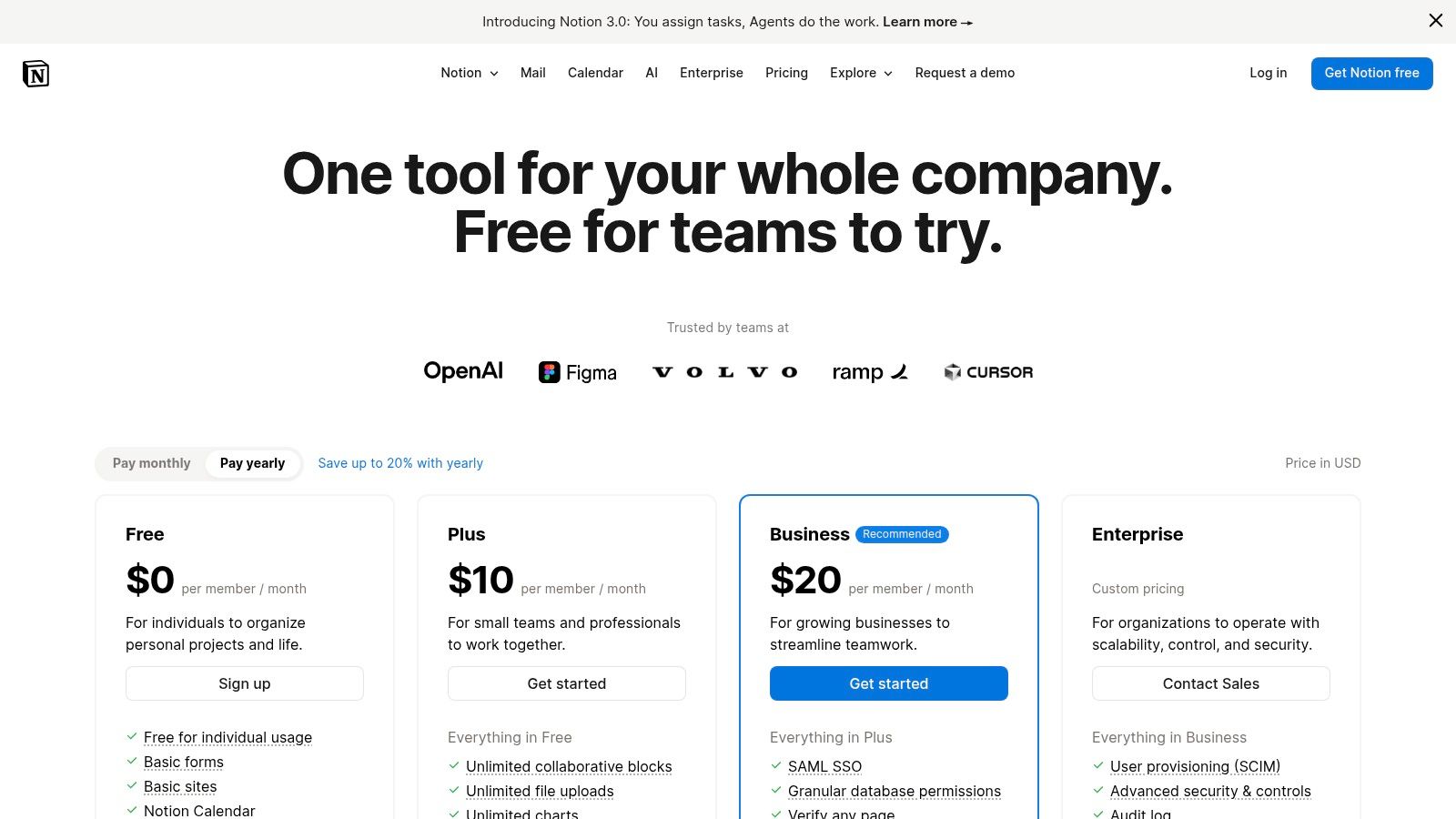
What makes Notion one of the most powerful tools for remote teams is its extreme adaptability and integrated AI. Unlike rigid project management tools, its block-based editor allows for complete customization. Notion AI, available on paid plans, can summarize meeting notes, draft content, and automate tasks directly within a document, significantly boosting productivity for asynchronous work. The platform’s granular permissions and teamspaces also ensure that sensitive information is accessible only to the right people.
Core Features & Limitations
Pros:
- Highly Flexible: Can be adapted for virtually any documentation or project management need, replacing multiple other applications.
- Consolidated Workspace: Serves as a central hub for company knowledge, reducing the need to switch between different tools. Learn more about how Notion fits into a suite of top remote collaboration tools for modern teams.
- Powerful AI Capabilities: Notion AI is deeply embedded to streamline content creation, summarization, and task management.
Cons:
- Paywalled Features: Critical admin controls, advanced security, and unlimited version history are restricted to more expensive Business and Enterprise tiers.
- Steep Learning Curve: The platform’s flexibility can be overwhelming without a well-planned information architecture, potentially leading to disorganized workspaces.
Website: https://www.notion.so/pricing/US?utm_source=openai
10. Miro
Miro is an online collaborative whiteboard that empowers distributed teams to co-create and innovate as if they were in the same room. It provides an infinite canvas for everything from brainstorming sessions and user story mapping to complex system diagrams. The platform is designed to make visual collaboration seamless, replacing physical whiteboards and sticky notes for remote-first companies.
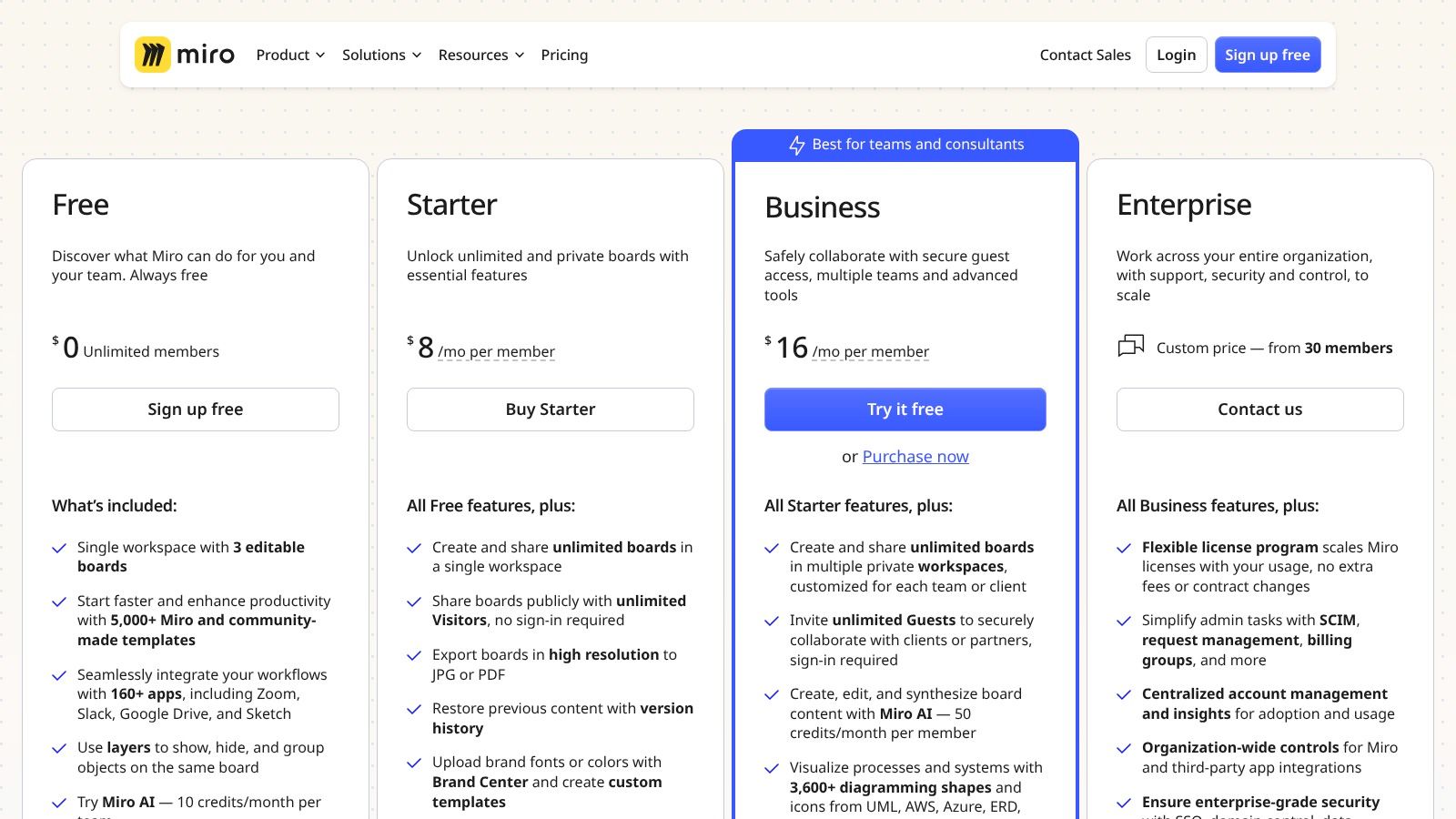
What truly makes Miro one of the essential tools for remote teams is its extensive library of over 3,000 templates and its built-in facilitation features. Tools like a timer, voting system, and integrated video chat transform static meetings into dynamic workshops. Furthermore, its deep integrations with project management software like Jira and Asana allow teams to turn ideas into actionable tasks directly from the board, bridging the gap between ideation and execution.
Core Features & Limitations
Pros:
- Best-in-class Visual Collaboration: Offers unparalleled features for workshops, sprint planning, and creative brainstorming sessions.
- Easy Guest Access: Simple for external stakeholders and clients to join boards and collaborate without needing a full account.
- Highly Scalable: Scales effectively from simple, individual boards to complex, multi-team workspaces for large-scale projects.
Cons:
- Performance Issues: Complex boards with many elements can become slow and lag on computers with lower-end specifications.
- Expensive Enterprise Features: Advanced security options like SSO/SCIM and data residency are gated behind higher-tier plans or require add-on purchases.
Website: https://miro.com/pricing//?utm_source=openai
11. GitHub
GitHub is the industry-standard platform for software development and version control, making it an indispensable tool for remote engineering teams. It provides a centralized hub for hosting code repositories, managing projects, and automating development workflows. The platform’s core strength lies in its Git-based version control, which allows distributed teams to collaborate on code asynchronously without conflict.
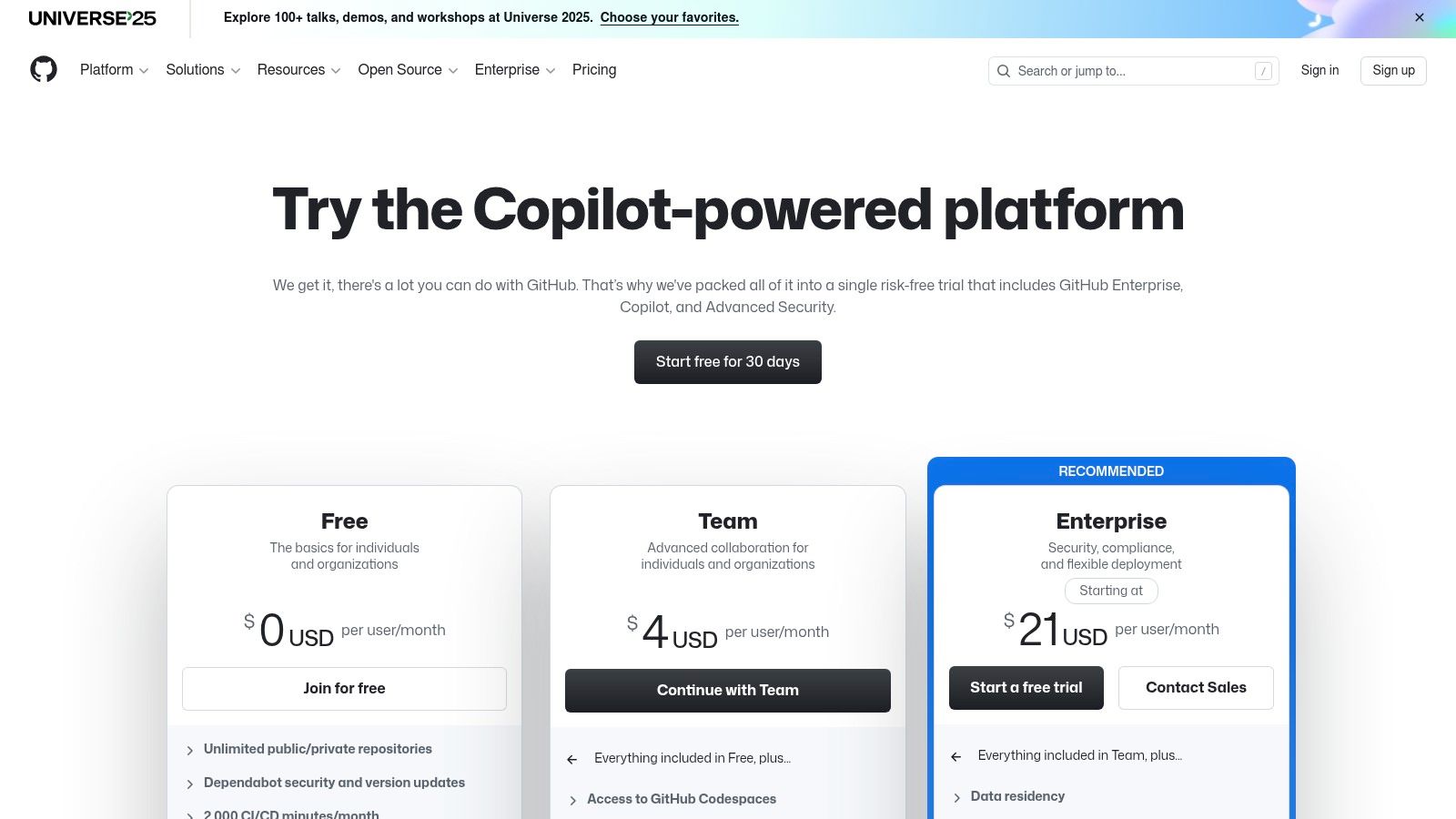
What makes GitHub essential for remote work is its comprehensive feature set beyond just code hosting. It includes integrated issue tracking, project boards, and powerful CI/CD automation through GitHub Actions. Features like Codespaces provide cloud-based development environments, standardizing setups for team members regardless of their local machine. This end-to-end ecosystem ensures that all development activities, from writing code to deployment, are transparent and collaborative, which is critical for teams working across different time zones.
Core Features & Limitations
Pros:
- End-to-End Platform: Integrates everything from code hosting and project tracking to CI/CD and package hosting in one place.
- Strong Community: Unparalleled support for open-source collaboration, offering a vast ecosystem of shared knowledge and reusable code.
- Powerful Enterprise Controls: Offers robust security features like SSO, audit logs, and data residency for enterprise-grade compliance.
Cons:
- Engineering-Focused: The interface and feature set are primarily tailored to technical users, which can present a learning curve for non-developers.
- Variable Costs: Usage-based pricing for GitHub Actions and Codespaces can lead to unpredictable monthly costs if not carefully managed.
Website: https://github.com/pricing?utm_source=openai
12. Amazon Business
Amazon Business is a procurement marketplace designed to streamline how companies purchase supplies and equipment for their distributed workforce. It provides a familiar shopping experience but adds powerful features tailored for organizational needs, making it one of the most practical tools for remote teams needing to equip home offices with everything from ergonomic chairs and monitors to essential software. The platform centralizes purchasing and simplifies expense management across a decentralized team.
What makes Amazon Business indispensable for remote operations is its multi-user account system with customizable approval workflows. Managers can set spending limits, create pre-approved product lists, and track purchases through detailed analytics, ensuring consistency and budget control. With business-only pricing and quantity discounts, it allows companies to efficiently scale their hardware and supply procurement while providing employees with fast, reliable shipping directly to their homes.
Core Features & Limitations
Pros:
- One-Stop Procurement: Offers a vast marketplace for remote work hardware, software, and supplies with fast shipping.
- Consolidated Purchasing Controls: Centralized billing, approval workflows, and spend analytics simplify procurement for distributed teams.
- Scalable for Any Size: The platform effectively serves everyone from sole proprietors to large enterprises with multiple plan tiers.
Cons:
- Paid Membership for Advanced Features: Key benefits like Guided Buying and extended payment terms are locked behind a Business Prime membership.
- Overwhelming Catalog: The extensive product selection can make it difficult to maintain equipment standards without creating approved lists.
Website: https://business.amazon.com/?utm_source=openai
Top 12 Remote Team Tools Comparison
| Platform | Core Features/Characteristics | User Experience/Quality ★ | Value Proposition 💰 | Target Audience 👥 | Unique Selling Points ✨ |
|---|---|---|---|---|---|
| 🏆 Remote First Jobs | 40,000+ verified remote jobs, advanced filters, spam-free | ★★★★★ Regularly updated, high trust | Transparent pricing, no hidden fees | Remote professionals & employers | Verified remote jobs, expert resources |
| Slack | Team messaging, channels, huddles, 2600+ integrations | ★★★★☆ Excellent integrations | Per-user billing, tiered AI features | Teams needing structured communication | AI summaries, rich app ecosystem |
| Microsoft Teams | Meetings, chat, Office app integration | ★★★★☆ Tight MS Office integration | Flexible licensing, add-ons for premium | MS Office users & enterprises | Office suite synergy, enterprise security |
| Zoom | HD video calls, webinars, chat, whiteboarding, add-ons | ★★★★☆ Reliable video/audio quality | Variable pricing, global dial-in transparency | Remote teams needing reliable video | Extensive add-ons, global coverage |
| Google Workspace | Gmail, Drive, Docs, Meet, Gemini AI | ★★★★☆ Intuitive and cloud-first | Competitive US pricing, free trials | Remote teams favoring Google ecosystem | Integrated AI, easy business email |
| Asana | Task/project tracking, timelines, reporting, AI workflows | ★★★★☆ Clear project visualization | Seat-based pricing, premium AI tools | Project managers & remote teams | AI-powered workflows, guest access |
| monday.com | Work OS, customizable boards, CRM, automation | ★★★★☆ Clean UI, mobile support | Pricing scales with seats, multiple SKUs | Distributed teams needing flexibility | Extensive templates, workflow automation |
| Atlassian (Jira & Confluence) | Agile project & knowledge management, extensive add-ons | ★★★★☆ Deep agile & reporting tools | Flexible hosting, enterprise-grade security | Engineering & product teams | Enterprise SSO, mature ecosystem |
| Notion | Docs, wikis, projects, databases, AI-enhanced tiers | ★★★★☆ Flexible multi-tool replacement | Tiered pricing, advanced permissions | Remote teams needing knowledge hubs | Embedded AI, customizable workspace |
| Miro | Collaborative whiteboard, templates, facilitation tools | ★★★★☆ Best visual collaboration | Higher-tier for enterprise security | Creative & interactive remote teams | Infinite canvas, advanced facilitation |
| GitHub | Code hosting, CI/CD, codespaces, project tracking | ★★★★☆ Comprehensive dev platform | Flexible pricing, usage-dependent costs | Engineering teams & open-source | End-to-end dev workflows, cloud IDE |
| Amazon Business | Business-only pricing, multi-user accounts, procurement tools | ★★★★☆ Efficient procurement | Business Prime required for full benefits | Companies equipping remote workers | Fast shipping, spend analytics |
Building Your Ultimate Remote Work Ecosystem
As we’ve explored, the transition to a successful remote-first model isn’t just a change in location; it’s a fundamental shift in how teams operate, communicate, and collaborate. The digital ecosystem you build is the bedrock of this new operational paradigm. Simply having access to a dozen applications isn’t the goal. The real objective is to curate a streamlined, integrated, and intuitive tech stack that empowers your team, rather than overwhelming them with digital noise and context switching.
The journey from a disparate collection of apps to a cohesive digital workplace requires a strategic, people-first approach. The tools we’ve detailed, from communication hubs like Slack and Microsoft Teams to project management powerhouses like Asana and monday.com, each solve a critical piece of the remote work puzzle. However, their true power is unlocked when they work in harmony, creating a seamless flow of information and a single source of truth for your entire organization.
From Selection to Implementation: Your Action Plan
Selecting the right tools for remote teams is a critical first step, but successful adoption is where the real work begins. Your path forward should be deliberate and phased. Don’t aim for a complete overhaul overnight. Instead, focus on incremental improvements that address your most significant pain points first.
Here is a practical framework to guide your decision-making and implementation process:
- Audit Your Current Stack and Identify Gaps: Before adding new software, map out what you already use. Are there redundancies? Is a specific area, like asynchronous documentation or creative brainstorming, critically underserved? Identifying these gaps prevents you from purchasing tools with overlapping features.
- Prioritize Based on Core Needs: Is your primary challenge maintaining project velocity, fostering cross-functional communication, or building a strong virtual culture? Pinpoint your top one or two priorities. If project visibility is the main issue, start by trialing a tool like Jira or Asana. If it’s about creating a central knowledge base, Notion or Confluence should be your focus.
- Run Pilot Programs with Small Groups: Never roll out a new, mission-critical tool to the entire company at once. Select a small, diverse team to act as a pilot group. Let them test the software in real-world scenarios for a few weeks and gather honest feedback. Their insights will be invaluable for a smoother, company-wide implementation and will help you create effective training materials.
- Develop Clear Guidelines and Best Practices: A tool is only as good as how it’s used. For each new platform, establish clear “rules of the road.” For example, define what conversations belong in Slack versus what should be a formal comment in a project management tool. Document these guidelines in a central place like your Confluence or Notion wiki.
The Human Element of Your Tech Stack
Ultimately, the best tools for remote teams are the ones that feel invisible. They should fade into the background, becoming a natural extension of your team’s workflow, not another hurdle to overcome. The goal is to reduce friction and empower your people to focus on high-impact work, creative problem-solving, and meaningful collaboration, regardless of their physical location. As you build out this foundation, it’s also important to consider the broader landscape of remote work resources. For a comprehensive look at establishing your ultimate remote work ecosystem, you might also explore other essential tools that can further enhance your team’s efficiency and find valuable insights in this guide to 12 Essential Tools to Master Remote Work.
Building a world-class remote team starts with the right people, but it’s scaled and sustained by the right technology. By thoughtfully selecting, integrating, and championing a powerful set of digital tools, you are not just enabling remote work; you are creating an environment where your team can truly thrive.
Once your digital ecosystem is in place, the next step is to fill it with exceptional talent. Remote First Jobs is more than just a job board; it’s a dedicated platform connecting innovative companies with top-tier professionals who are committed to the remote-first mindset. Find the perfect candidates to build your high-performing remote team on Remote First Jobs today.






